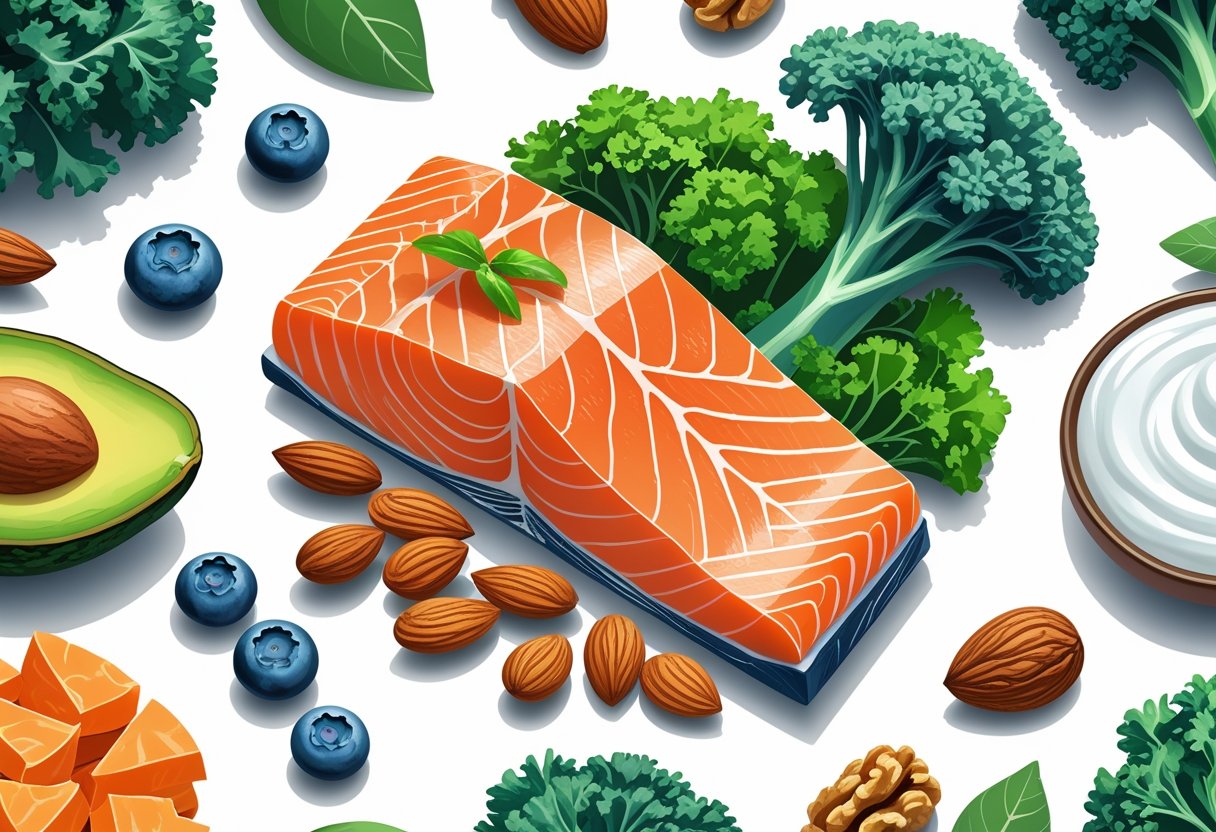Healthy eating really matters for feeling good and keeping chronic diseases at bay. Plenty of foods pack in essential nutrients that keep your body running, boost your energy, and might even help you live longer. Picking the right foods can balance your diet and nudge your health in the right direction over time—though, let’s be honest, nobody eats perfectly all the time.
The 10 most healthy foods are those that deliver a lot of nutrients without much downside, so you can eat them often and feel good about it. You’ll see a mix here—fruits, veggies, grains, nuts, seeds, and lean proteins. Knowing what packs the most nutritional punch makes it a lot easier to build a better plate.
1) Salmon

Salmon stands out for its impressive nutrient profile. It’s loaded with omega-3 fatty acids, which are great for your heart and might help lower blood pressure or even reduce the risk of heart rhythm issues.
This fish brings plenty of quality protein and vitamins like B vitamins and potassium, all of which help keep your energy up and your body humming along.
Wild-caught salmon (think Sockeye or King) usually has more omega-3s, but well-managed farmed salmon is also a solid choice and tends to be pretty low in mercury.
It’s easy to pair salmon with veggies, grains, or healthy fats, so you can mix things up and keep meals interesting.
Most experts suggest eating salmon about twice a week to keep your heart strong and get a steady supply of those good nutrients.
2) Broccoli

Broccoli is a nutrient-dense veggie, stacked with vitamin C, vitamin K, fiber, and folate. It’s hard to find a vegetable that packs more in each bite.
The fiber in broccoli helps keep your digestion moving and may even help tame inflammation. Its vitamin K and calcium are good for your bones, and the antioxidants inside help your immune system stay on guard.
Eat it raw or cooked—either way, you’ll get the benefits. Honestly, how you make it matters less than making sure it ends up on your plate regularly.
Broccoli’s pretty adaptable, so you can toss it in salads, stir-fries, or just eat it steamed. No need to overthink it.
3) Kale
Kale is a nutrient-dense leafy green, loaded with vitamins A, C, and K, plus minerals like calcium, potassium, and magnesium. One cup of raw kale barely has any calories but still covers a big chunk of your daily needs.
Thanks to all that vitamin K, it’s good for your bones, and the vitamin C helps keep your immune system in shape. Antioxidants in kale might protect your cells, though, of course, nothing’s magic.
You can eat kale raw in salads or smoothies, or cook it in soups and stir-fries. Cooking does change some nutrients, but it can actually help your body absorb others—so, it’s a trade-off.
Eating kale often adds fiber for better digestion and gut health, plus a little omega-3 for your heart.
4) Spinach
Spinach is another leafy green heavy-hitter, packed with vitamins A and C, iron, and calcium. It’s a go-to for overall nutrition.
Chlorophyll and carotenoids in spinach are good for your eyes and might lower your risk of some vision problems down the line.
Since it’s low in calories but high in fiber, spinach helps with digestion and can keep you feeling fuller for longer. That’s handy if you’re watching your weight.
Its antioxidants could help your heart, and the nutrients support your immune system and skin.
Spinach doesn’t have a strong flavor, so you can toss it in pretty much anything—salads, smoothies, omelets, you name it.
5) Beets
Beets are those bright red root veggies with an earthy taste. They’re full of vitamins, minerals, and antioxidants that help with overall health.
One standout in beets is dietary nitrate, which your body turns into nitric oxide. That relaxes blood vessels and can lower blood pressure.
With plenty of fiber, beets help your digestion and gut. Their antioxidants may cut down on inflammation and protect your cells, too.
Some people even eat beets to boost blood flow and athletic performance. You can eat them raw, roasted, steamed, or juiced—whatever works for you.
6) Almonds
Almonds are little nutrition powerhouses—packed with protein, healthy fats, fiber, and a bunch of vitamins and minerals. They’re especially good for your heart, helping to lower cholesterol and inflammation.
A small handful gives you steady energy and keeps hunger at bay, thanks to the mix of protein, fiber, and fat. Almonds can even help with weight management.
They’re also linked to better brain function and healthier skin, mostly due to their antioxidants. Eat them raw, roasted, or mixed into recipes—they’re pretty forgiving.
Since most almonds come from California, they’re easy to find. Research backs up the benefits, especially for heart and metabolic health.
7) Blueberries
Blueberries are tiny but mighty, loaded with antioxidants, vitamins, and minerals. Vitamin K helps your heart and blood, and the antioxidants protect your cells from free radical damage.
Some studies suggest blueberries could help your brain and memory, and regular eaters might have a lower risk of things like heart disease and diabetes.
Eat them fresh, frozen, or dried—they’re low-calorie and easy to snack on. Their natural sweetness makes them a favorite for a reason.
8) Sweet potatoes
Sweet potatoes are packed with vitamins A and C, iron, potassium, and fiber. Just one medium sweet potato covers your vitamin A for the day, no problem.
Carotenoids in sweet potatoes help your eyes and immune system, and the fiber helps your digestion run smoothly.
They’re anti-inflammatory and their potassium helps keep your blood pressure in check. Plus, they’re low in fat and have more protein than you’d expect from a root veggie.
9) Greek yogurt
Greek yogurt is a protein-packed option, usually giving you 10 to 20 grams per serving. That’s great for muscle repair and makes you feel full longer.
It’s got live active cultures, which are good for your gut and digestion. If you pick plain, non-fat, or low-fat varieties, you’ll avoid extra sugar.
The best Greek yogurts have just milk and cultures—no funny stuff. Brands like Fage Total 0% or Chobani Plain Non-Fat tend to get the nod from dietitians.
It’s also a solid source of calcium for your bones, and you can use it in all sorts of dishes, from breakfast bowls to savory dips.
10) Quinoa
Quinoa is a gluten-free whole grain that’s pretty high in protein—almost double what you get from brown rice. That makes it a great pick for plant-based protein needs.
It’s got fiber, iron, zinc, and a mix of vitamins, so it’s more than just a carb. The fiber helps your digestion and steadies your blood sugar.
Quinoa also brings plant compounds and antioxidants to the table, and it cooks up quickly, which is a bonus.
You can swap it in for rice or bulgur, or toss it in salads and bowls. It’s an easy way to add variety and nutrition without much fuss.
Key Nutrients in the Most Healthy Foods
Healthy foods are loaded with nutrients that your body actually needs—vitamins, minerals, antioxidants, and the right kinds of fats. Each one plays a different role, and together they help keep you feeling your best and may lower your risk of chronic problems.
Essential Vitamins
Vitamins are the behind-the-scenes helpers for metabolism, immunity, and tissue repair. Leafy greens, fish, and whole grains all bring something to the table.
Vitamin A (from sweet potatoes, kale) helps your eyes and skin. Vitamin C (think broccoli, citrus) gives your immune system a lift and helps with collagen. B vitamins, like B6 and riboflavin, are key for energy and red blood cells. Fat-soluble vitamins D and E (you’ll find them in fish and nuts) support bone health and protect your cells.
Minerals and Antioxidants
Minerals help enzymes work, keep your nerves firing, and make your bones strong. Antioxidants step in to neutralize free radicals and fend off cell damage.
Calcium and magnesium (from leafy greens and nuts) build bones and keep muscles working. Iron (from meats and legumes) moves oxygen around your body. Potassium keeps your heart and blood pressure steady. Antioxidants like beta-carotene and flavonoids (in colorful fruits and veggies) help fight inflammation and keep your cells healthy.
Healthy Fats
Healthy fats give you energy, support cell growth, and help your brain work. They also calm inflammation, which is a big deal.
Omega-3s (from salmon, chia seeds) are linked to better heart and brain health. Monounsaturated fats (in olive oil, nuts) can help lower bad cholesterol. These fats help your body absorb vitamins and make hormones, while saturated and trans fats—well, those you really want to keep in check.
How to Incorporate Healthy Foods Into Daily Meals
Bringing more healthy foods into your daily meals takes a bit of planning and mindful cooking. Choosing ingredients you actually like, and cooking them in ways that keep their nutrition, can make eating well feel less like a chore and more like something you might actually look forward to.
Simple Meal Planning Strategies
When you plan your meals ahead, it’s a lot easier to eat healthy foods regularly. I usually start with a quick list of proteins—maybe fish, beans, or eggs—then add a couple of veggies like broccoli, carrots, or whatever’s in season. That’s the base, and it honestly keeps things pretty balanced.
If you cook up a batch of brown rice or wholewheat pasta, you’ll have options ready to go all week. I’m a fan of tossing in snacks like almonds or a spoonful of peanut butter too—they’re easy, and they keep me from reaching for less healthy stuff when I’m hungry.
Jotting down a weekly menu that mixes up different fruits, veggies, and proteins helps keep things interesting. Prepping ingredients ahead—like washing and chopping your veggies—makes it way less tempting to just order takeout when you’re tired.
Cooking Methods to Preserve Nutrition
Some cooking techniques just do a better job at keeping nutrients in your food. Steaming vegetables, for example, usually holds onto more vitamins than boiling ever does.
Grilling or baking fish and lean meats helps you skip extra fats and keeps the texture and flavor. Try to avoid deep frying or letting things cook too long—those methods tend to sap nutrition.
If you use oil, keep it minimal and go for healthier picks like olive oil. When you reheat food, do it gently so you don’t lose more nutrients than you have to.




